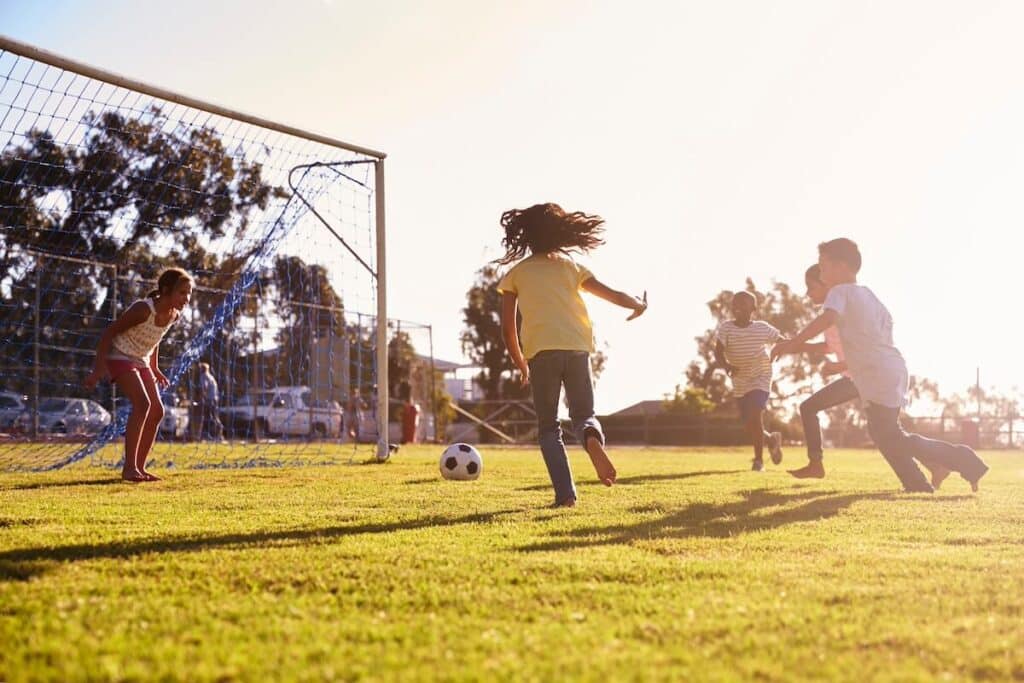Being physically active has so many health benefits for children and adolescents. In today’s world, technology often rules and it’s difficult to coax kids away from phones and video games to get outside and get moving. A value of ours at Laura Cipullo Whole Nutrition is moving your body in fun and joyful ways and never using it as a punishment or means to earn something. Movement should also not be associated with a means to control your weight, but rather a daily activity as routine as brushing your teeth or taking a shower. This mindset helps kids foster a healthy relationship with physical activity.
We talked to Coach Mike Shipper, founder of Empowered Sports & Fitness, a certified personal trainer and one of our go-to resources for empowering our clients to get moving.
“Tell us a little bit about you and your philosophy when it comes to exercise.”
I am a certified personal trainer with additional certifications in physical literacy and autism fitness. Physical literacy focuses on creating competence and confidence through a wide variety of movements (i.e. improving perceptual motor skills – such as visual tracking, auditory processing, vestibular awareness, body awareness, directional awareness, temporal awareness, and proprioceptive awareness). As an Autism Fitness Specialist, we work with our athletes to improve their physical abilities, adaptive abilities, and cognitive abilities.
Empowered Sports and Fitness Specialty is providing inclusive opportunities for athletes of all abilities and backgrounds to be active, have fun, and take part in a program that understands their needs. Our perspective is unique because we utilize the method of play to introduce sports and fitness to athletes. When you’re playing and having fun, you’re not thinking of what you’re doing as work. I learned this method as a kid growing up and attending a school for kids with learning disabilities.
“What benefits do you see the kids you work with receive from working with you and your team?”
Many of the families we work with come to us because they find the organized sports approach is not a good fit for their child. They are looking for a program that can make fitness and sports fun, creative, and engaging in a different way. And what I mean by a different way is that we create custom programs to fit the physical, adaptive, and cognitive needs of the athlete and the goals of the parents. The benefits our athletes receive from our sessions include:
- Structure
- Routine
- Consistency
- Building Confidence
- Improving Social and Emotional Skills
“How do you think movement helps kids with poor body image?”
Movement and physical activity can be highly beneficial for children struggling with poor body image. Here are several ways in which movement helps:
-
Improved Physical Health
Regular physical activity improves physical health, including strength, endurance, flexibility, and overall fitness. As children notice improvements in their physical abilities, they often feel more confident and positive about their bodies.
-
Mental Health Benefits
Exercise is known to reduce symptoms of anxiety and depression, which are often linked to body image issues. Physical activity releases endorphins, the body’s natural mood lifters, helping children feel happier and more relaxed.
-
Enhanced Self-Esteem
Successfully engaging in physical activities and achieving fitness goals can boost a child’s self-esteem. Mastering a new skill or sport can provide a sense of accomplishment and pride in their abilities.
-
Healthy Habits Formation
Incorporating regular physical activity into daily routines helps children develop healthy habits that can last a lifetime. These habits contribute to a balanced lifestyle and a more positive view of one’s body.
“What are your favorite ways to motivate kids to get moving?”
Motivating kids to get moving, especially through the lens of inclusion, involves creating an environment where every child feels welcome, valued, and capable of participating. Here are some of my favorite strategies:
-
Inclusive Activities:
- Adapted Sports and Games: Modify traditional games to accommodate different abilities. For example, using larger balls, reducing field size, or adjusting rules to ensure everyone can participate.
- Buddy Systems: Pair children of different abilities together so they can support and motivate each other.
-
Variety and Choice:
- Offer Diverse Activities: Provide a range of activities (dancing, yoga, obstacle courses, team sports) to cater to different interests and abilities.
- Let Kids Choose: Allow children to have a say in what activities they want to participate in. This can increase their enthusiasm and engagement.
-
Positive Reinforcement:
- Celebrate Effort and Improvement: Focus on personal bests and progress rather than competition. Praise efforts, not just outcomes.
- Incentive Programs: Use stickers, certificates, or small rewards to recognize participation and effort.
-
Engaging Environments:
- Fun and Playful Atmosphere: Create an environment that feels more like play than exercise. Use music, colorful equipment, and themed activities.
- Safe and Supportive Spaces: Ensure that the environment is physically and emotionally safe for all children. Address bullying and promote respect and kindness.
“Any tips for parents about how to speak to their kids about exercise?”
Speaking to kids about exercise in a heartfelt way involves more than just promoting physical activity; it’s about fostering a lifelong appreciation for health, wellness, and self-care. Here are some tips for parents:
-
Lead by Example
- Be a Role Model: Show your kids that you value exercise by making it a regular part of your life. Participate in activities you enjoy and let your kids see you being active.
- Family Activities: Engage in family-oriented physical activities like hiking, biking, or playing sports together. This makes exercise a fun and shared experience.
-
Focus on Fun
- Enjoyment Over Obligation: Emphasize the fun aspects of exercise rather than treating it as a chore. Find out what activities your child enjoys, whether it’s dancing, swimming, or playing soccer.
- Variety: Introduce a variety of activities to keep things exciting and to help your child find what they love.
-
Emphasize the Benefits Beyond Physical Health
- Mental Well-being: Talk about how exercise can help reduce stress, improve mood, and boost self-esteem.
- Social Benefits: Highlight how team sports or group activities can help them make friends and develop teamwork skills.
-
Use Positive Reinforcement
- Celebrate Efforts: Praise your child for their efforts, not just their achievements. Recognize their progress and encourage their enthusiasm.
- Encouragement: Use positive language and encouragement to motivate your child. Avoid using guilt or pressure to get them to exercise.
-
Be Age-Appropriate
- Tailor the Message: Adjust your conversation based on your child’s age and understanding. For younger kids, keep it simple and fun. For older kids, you can talk more about the importance of maintaining a healthy lifestyle.
-
Integrate Exercise into Daily Life
- Daily Routines: Encourage activities that can be integrated into daily routines, like walking or biking to school, taking the stairs, or doing household chores.
- Limit Screen Time: Encourage breaks from screens and suggest active alternatives like playing outside or participating in sports.
-
Share Your Own Experiences
- Personal Stories: Share your own experiences with exercise, including what you enjoy and how it makes you feel. This makes the conversation more relatable and sincere.
- Acknowledge Challenges: Be honest about the challenges of staying active and how you overcome them. This teaches resilience and perseverance.
-
Make it About Health, Not Weight
- Avoid Weight Focus: Steer the conversation away from weight and towards overall health and well-being. Emphasize strength, energy, and feeling good.
- Body Positivity: Foster a positive body image by talking about what their body can do rather than how it looks.
-
Create a Supportive Environment
- Access to Resources: Provide access to the necessary resources, such as sports equipment, safe places to play, and transportation to activities.
- Encourage Peer Support: Support their participation in group activities where they can bond with peers who also enjoy being active.
-
Be Patient and Persistent
- Consistency: Encourage regular physical activity as a habit, but be patient if your child is reluctant at first. Keep offering opportunities without forcing them.
- Long-term View: Understand that developing a love for exercise can take time. Keep the conversation open and ongoing.
By approaching the topic of exercise with empathy, enthusiasm, and understanding, you can help your child develop a healthy and positive relationship with physical activity that lasts a lifetime.
“What are your personal favorite ways to move?”
I love to incorporate exercise into my daily routines through a variety of activities that are both effective and engaging. However, my absolute favorite form of exercise is walking! I was born and raised in New York City and from the moment I was able to take my first steps (8 months) I have not looked back. Nowadays you will find me and my wife walking our two Cocker Spaniels (Winne and Clover) all over the city. The key to maintaining a regular exercise routine is finding an activity that you enjoy, as it increases the likelihood of sticking with it long-term.








